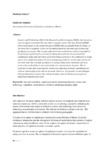
Please use this identifier to cite or link to this item:
http://ricaxcan.uaz.edu.mx/jspui/handle/20.500.11845/175Full metadata record
| DC Field | Value | Language |
|---|---|---|
| dc.contributor.other | 0000-0002-7441-3233 | |
| dc.coverage.spatial | Global | es_ES |
| dc.creator | Foladori, Guillermo | |
| dc.date.accessioned | 2017-04-27T15:20:37Z | |
| dc.date.available | 2017-04-27T15:20:37Z | |
| dc.date.issued | 2016-03 | |
| dc.identifier | info:eu-repo/semantics/publishedVersion | |
| dc.identifier.issn | 1740-2743 | es_ES |
| dc.identifier.uri | http://hdl.handle.net/20.500.11845/175 | |
| dc.description.abstract | Science and Technology (S&T), like Research and Development (R&D), has become a case of capital investment like any other economic sector. This has distanced R&D from social needs, to the extent that part of R&D ends up actually being fictitious, in the sense that it acquires a price on the market but never becomes part of material production processes. The concept referred to here as fictitious science is parallel to the fictitious capital used to account for financial assets that have no material counterpart. R&D and S&T have gone from being a service to the community to being sectors for capital investment, driven to producing profits by cost-benefit criteria. At the same time that scientific production is being productively exploited, a form of science has evolved that is not evaluated for its content but for its price. This is fictitious science that is not used for production and ends up being superfluous and with no relationship at all with social needs. However, the paradox is that although their products have a price, they end up in many cases not being used as part of material production processes. | es_ES |
| dc.language.iso | eng | es_ES |
| dc.publisher | History, Philosophy and Didactics of Science and Technology Programme | es_ES |
| dc.relation | http://www.jceps.com/wp-content/uploads/2016/04/14-1-6.pdf | es_ES |
| dc.relation.uri | generalPublic | es_ES |
| dc.rights | Attribution-NonCommercial-ShareAlike 3.0 United States | * |
| dc.rights.uri | http://creativecommons.org/licenses/by-nc-sa/3.0/us/ | * |
| dc.source | Journal for Critical Education Policy Studies, Vol. 14, No. 1, pp. 86-101. | es_ES |
| dc.subject.classification | CIENCIAS AGROPECUARIAS Y BIOTECNOLOGIA [6] | es_ES |
| dc.subject.other | info:eu-repo/classification/Financial capitalism | |
| dc.subject.other | info:eu-repo/classification/Capital investment | |
| dc.subject.other | info:eu-repo/classification/Science and technology | |
| dc.subject.other | info:eu-repo/classification/Intellectual property rights. | |
| dc.subject.other | info:eu-repo/classification/Propiedad intelectual | |
| dc.subject.other | info:eu-repo/classification/Ciencia y tecnología | |
| dc.subject.other | info:eu-repo/classification/Inversiones de capital | |
| dc.subject.other | info:eu-repo/classification/Capitalismo | |
| dc.title | Fictitious Science | es_ES |
| dc.type | info:eu-repo/semantics/article | es_ES |
| Appears in Collections: | *Documentos Académicos*-- UA Estudios del Desarrollo | |
Files in This Item:
| File | Description | Size | Format | |
|---|---|---|---|---|
| Foladoi, Guillermo. Fictitious Science.pdf | Versión publicada | 366,07 kB | Adobe PDF |  View/Open |
This item is licensed under a Creative Commons License
